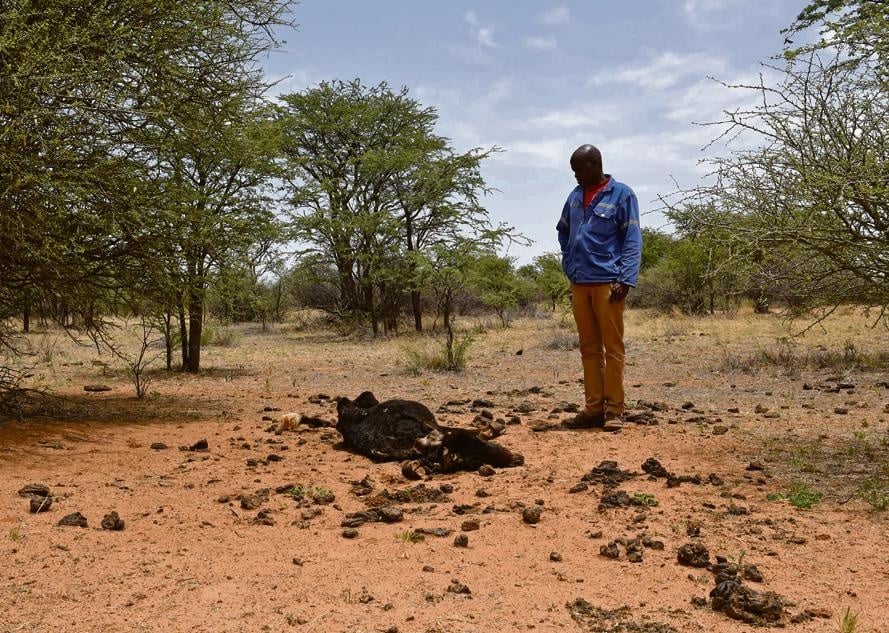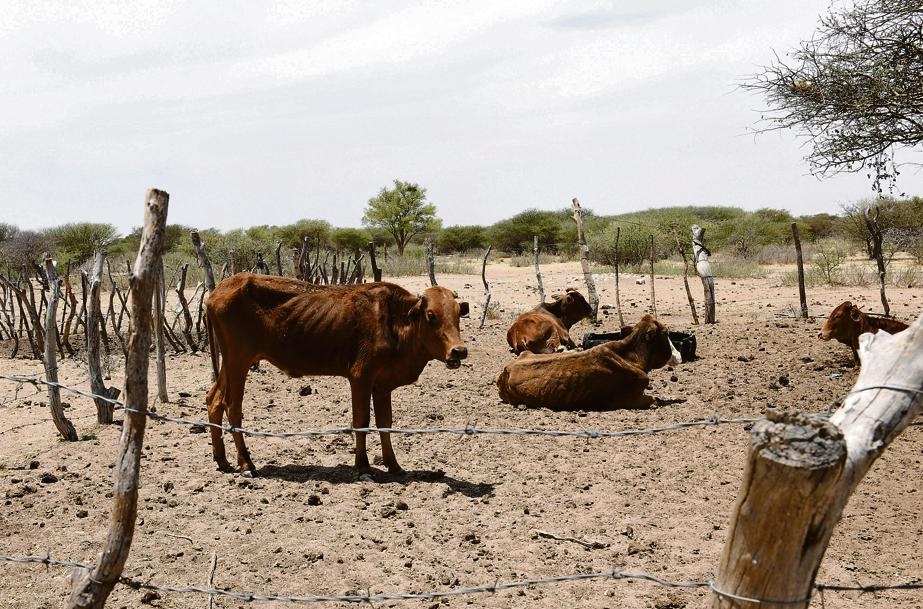
Small-scale farmers are desperate for help from government to save their herds of cattle as drought ravages large parts of South Africa
The green canopy of drought-tolerant acacia thorn trees you see as you approach the village paints a deceptive picture from a distance.
A depressing sight awaits just a few kilometres into the wild and the landscape becomes even more arid as you drive further into the area.
This should be grazing land, but the dust blowing into the cattle’s noses as they search for something to chew on is an unbearable sight.
With no grass left and water points having dried up, this is no place for animals.
However, subsistence farmers in the area have no one to turn to and nowhere else to go.
Located outside Disaneng village, west of Mahikeng in North West, this gloomy situation shows the devastating impact the severe drought is having on communities across parts of the country.
It has left a trail of carcasses dotting desiccated terrains.
Agri SA, the federation of agricultural organisations, recently gave an idea of how severe the drought was using the hardest-hit province – the Northern Cape – as an example of the devastation.
“In the Northern Cape, government has already allocated drought relief to the value of R30 million, while R50 million has been allocated in the Western Cape,” said Willem Symington, Agri SA’s head of disaster management.
“This, however, is not enough. We estimate that at least R425 million will be needed to mitigate the drought in the Northern Cape alone.”
THE PAIN OF COUNTING LOSSES
Kgotlaetsile Mongale’s grief over the loss of his cattle is etched on his face as he stands next to the remains of what used to be “money on four legs” for him.
He owns a small plot which is surrounded by communal grazing land outside Disaneng.
Farmers were used to getting enough rain for the grass to grow and provide grazing for their animals.
A spot where the carcass lies bears all the signs that the animal battled for some time – it probably turned and tossed on the ground struggling to get up until it took its last breath.
After the vultures and other carnivores in the bush feasted on it, what remains are a few bones covered by a dried-up hide.
Using one hand, Mongale picks up the lightweight carcass, the animal’s stiff tail jutting out like a mannequin.
“I don’t know how to express the pain of what you are seeing right now. I lost 26 cattle in the last drought and my fear is that this could be the beginning of another chapter of sorrow,” he says.
“I am still searching for four of my cattle and I pray that I do not come across their carcasses like this one. We need rain to save us from this misery.”
Mongale’s daily routine starts early in the morning when he goes to the communal grazing fields to collect the cattle.
He leads them for about 5km to his homestead for water.
There are no water points anywhere close to the grazing fields and because there is no grass either, many of the cattle do not make it to their next drinking point, succumbing to hunger and thirst in the bushes.
Read: ‘Devil’s cactus’ invades drought-stricken farms and kills livestock in Kenya
Mongale cannot afford fodder for them.
“Even if I wanted to sell a few of them so I can buy feed and medication, there is no one out there who would buy clearly emaciated cattle. We’re desperate for help as subsistence farmers. We need water and feed to keep these animals alive,” he says.
Another farmer, Goitseone Leburu, reiterates Mongale’s plea for assistance.
“We are helpless now. There is no grass for our animals to feed on or water to drink,” Leburu says.
His family lost more than 10 cattle during the last drought. None have died so far as they are keeping them alive by ferrying water from the village to their smallholding.
“We’re battling to keep them alive and as you can see, most of them are left only with the hide covering bones and you can easily count their ribs,” he says.
FARMERS’ LAST HOPE
The farmers said their last hope was getting assistance from the department of agriculture.
Chief Sandylands Motseoakhumo, a traditional leader of the Makgobistad village about 15km from Disaneng, said struggling farmers have formed a forum.
A representative will formally approach the department for help.
“The department has also been meeting farmers and we are hopeful that our people will be helped, and animals saved. The drought has been devastating but very little of it has been shown to the public. We live in an area where drought-resilient thorn trees are always green, but at the bottom of their trunks there is no grass at all for animals to feed on,” Motseoakhumo said.
“The other problem now is that animals get water from villages and it leads to resources being overburdened and underground water and aquifers getting depleted. There is an urgent need for assistance otherwise we’re heading for the worst crisis where we will soon have carcasses of animals strewn all over the place. If this disaster is allowed to get worse, many families will be robbed of their livelihoods.
“Farmers are dying in silence. The pain of helplessly watching your cattle perish is like watching tens of thousands of rands’ worth of bank notes reduced to ashes in a raging fire,” Motseoakhumo said.
“We see on television that farmers in other areas are getting loads of feed for their animals and there are drought relief programmes to save their animals. We also need that and for the looming catastrophe of this devastating drought to be avoided. We’re hopeful our government and private donors will look our way.”
Dipepeneneng Serage, North West agriculture’s head of department, said the province’s livestock headcount had drastically declined from about 970 000 in 2012 to around 500 000 after persistent droughts in recent years.
Taking into account that a small-scale farmer owns on average about 17 cattle, this means that about 27 000 of them were affected.
“A decline of such numbers also implies there were huge job losses from small-scale and commercial farmers in the past five years.”
Serage said the most affected areas were in Kagisano Molopo municipality, from Tosca all the way up to Taung.
“Poverty and food insecurity levels in the area are among the highest, hence our presence this week where we are profiling indigent households for possible assistance.”
Serage said the department had so far provided 800 bags of fodder to farmers around Tosca and had to date spent R6.2 million on 37 000 bags of the same feed benefiting 1 885 farmers in the Kagisano Molopo municipality.
His department had “submitted a request for drought relief assistance to national government towards the assistance of 17 730 farmers in prioritised areas, amounting to R70.9 million”, he said.
| |||||||||||||
| |||||||||||||




 Publications
Publications
 Partners
Partners








